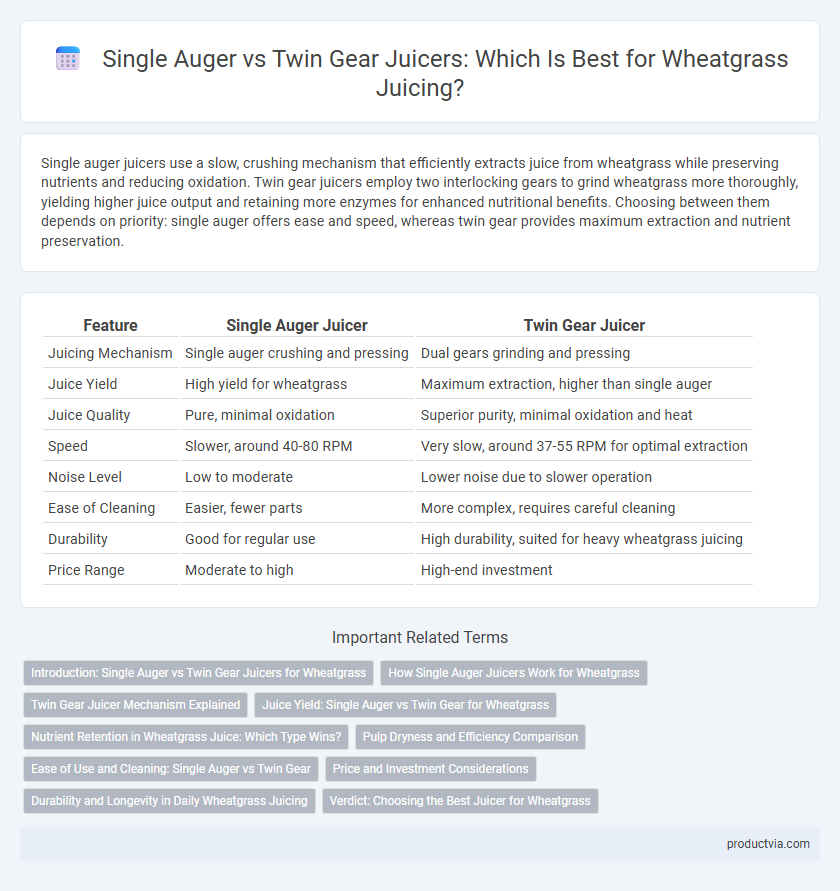Single auger juicers use a slow, crushing mechanism that efficiently extracts juice from wheatgrass while preserving nutrients and reducing oxidation. Twin gear juicers employ two interlocking gears to grind wheatgrass more thoroughly, yielding higher juice output and retaining more enzymes for enhanced nutritional benefits. Choosing between them depends on priority: single auger offers ease and speed, whereas twin gear provides maximum extraction and nutrient preservation.
Table of Comparison
| Feature | Single Auger Juicer | Twin Gear Juicer |
|---|---|---|
| Juicing Mechanism | Single auger crushing and pressing | Dual gears grinding and pressing |
| Juice Yield | High yield for wheatgrass | Maximum extraction, higher than single auger |
| Juice Quality | Pure, minimal oxidation | Superior purity, minimal oxidation and heat |
| Speed | Slower, around 40-80 RPM | Very slow, around 37-55 RPM for optimal extraction |
| Noise Level | Low to moderate | Lower noise due to slower operation |
| Ease of Cleaning | Easier, fewer parts | More complex, requires careful cleaning |
| Durability | Good for regular use | High durability, suited for heavy wheatgrass juicing |
| Price Range | Moderate to high | High-end investment |
Introduction: Single Auger vs Twin Gear Juicers for Wheatgrass
Single auger juicers use one slow-rotating screw to crush wheatgrass, offering efficient juice extraction with minimal oxidation and heat buildup. Twin gear juicers utilize two interlocking gears that crush and grind wheatgrass more thoroughly, resulting in higher juice yield and enhanced nutrient preservation. For wheatgrass juicing, twin gear models generally provide superior extraction quality but are often more expensive and require more maintenance than single auger juicers.
How Single Auger Juicers Work for Wheatgrass
Single auger juicers operate by slowly crushing wheatgrass against a strainer to extract maximum juice while minimizing heat buildup and oxidation, preserving nutrients and enzymes. The continuous pressing mechanism efficiently separates juice from fibrous wheatgrass pulp, which results in higher juice yield and longer shelf life compared to centrifugal juicers. This slow, cold-press method is ideal for wheatgrass, maintaining its delicate vitamins and antioxidants for optimal health benefits.
Twin Gear Juicer Mechanism Explained
Twin gear juicers utilize dual interlocking gears that rotate inwardly at slower speeds to crush and grind wheatgrass, maximizing nutrient extraction and juice yield. This mechanism generates minimal heat and oxidation, preserving enzymes and vitamins that are often lost in single auger juicers. The improved masticating process of twin gear systems ensures a higher-quality, nutrient-dense wheatgrass juice compared to single auger machines.
Juice Yield: Single Auger vs Twin Gear for Wheatgrass
Twin gear juicers generally produce a higher juice yield from wheatgrass compared to single auger models due to their dual-masticating technology that efficiently crushes and presses the fibers. Single auger juicers operate at slower speeds with one rotating component, extracting juice by grinding and pressing, but may leave more pulp and reduce overall yield. Opting for a twin gear juicer maximizes wheatgrass juice output by thoroughly breaking down plant cell walls, enhancing nutrient extraction and liquid volume.
Nutrient Retention in Wheatgrass Juice: Which Type Wins?
Single auger juicers operate at lower speeds, minimizing heat generation and oxidation, which helps preserve higher levels of chlorophyll, enzymes, and antioxidants vital for nutrient retention in wheatgrass juice. Twin gear juicers, featuring dual interlocking gears, crush wheatgrass more thoroughly and extract maximum juice, resulting in a nutrient-dense output with enhanced vitamins and minerals. While both excel in preserving nutrients, twin gear juicers generally yield juice with superior nutrient retention due to their efficient grinding and slower operation minimizing nutrient degradation.
Pulp Dryness and Efficiency Comparison
Single auger juicers typically produce drier pulp due to slower crushing speed, maximizing juice extraction from wheatgrass and enhancing efficiency. Twin gear juicers, while more expensive, ensure superior juice yield with minimal oxidation, resulting in exceptionally dry pulp and higher nutrient retention. Comparing pulp dryness and efficiency, twin gear models surpass single augers by delivering richer juice and more compact residual pulp.
Ease of Use and Cleaning: Single Auger vs Twin Gear
Single auger juicers offer superior ease of use with their straightforward assembly and fewer parts, simplifying the cleaning process compared to twin gear juicers. Twin gear juicers, while delivering higher juice yield, require more meticulous disassembly and cleaning due to their complex mechanism and multiple gears. Users seeking quick setup and minimal maintenance often prefer single auger models for wheatgrass juicing convenience.
Price and Investment Considerations
Single auger juicers typically offer a more affordable initial price, making them a popular choice for budget-conscious wheatgrass juicing enthusiasts. Twin gear juicers require a higher upfront investment but provide superior juice yield and nutrient extraction, potentially delivering better long-term value. Evaluating frequency of use and juicing goals helps determine whether the initial cost or long-term performance holds greater importance.
Durability and Longevity in Daily Wheatgrass Juicing
Single auger juicers often provide strong durability with fewer moving parts, reducing wear during daily wheatgrass juicing. Twin gear juicers feature interlocking gears that exert higher pressure, enhancing extraction but potentially increasing mechanical stress over time. For long-term wheatgrass juicing, twin gear models typically offer superior longevity due to robust construction and heavy-duty components designed for frequent, intensive use.
Verdict: Choosing the Best Juicer for Wheatgrass
Single auger juicers efficiently extract wheatgrass juice with minimal oxidation, preserving nutrient density and delivering a smooth texture ideal for daily use. Twin gear juicers provide superior juice yield and nutrient retention by crushing wheatgrass slowly and thoroughly, though they tend to be more expensive and require more cleaning. For most wheatgrass enthusiasts prioritizing convenience and juice quality, a high-quality single auger juicer offers the best balance of performance and value.
Single auger vs twin gear for wheatgrass juicing Infographic

 productvia.com
productvia.com